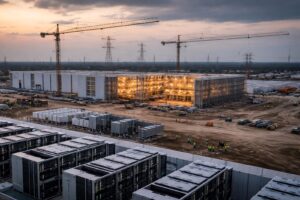2025 has become a watershed moment for battery infrastructure. As the race to build domestic gigafactories intensifies, the rules of site selection are shifting. Greenfields no longer own the default status. Instead, brownfield gigafactory sites are emerging as strategic power plays—bringing speed, cost efficiency, and ESG alignment. This article explores why brownfields are trending, what’s accelerating their rise, and how leaders are navigating the deeper challenges tied to reuse.
Why Brownfield Gigafactory Sites Outperform in Deployment
Before you consider macro pressures or policy incentives, you have to look at what makes these sites so attractive on their terms. This section explores the practical, structural reasons developers are gravitating toward brownfields—and why they’re proving faster, leaner, and more reliable than expected:
Avoiding New Land Procurement Delays in Competitive Markets
Securing land for a new build has become one of the messiest parts of the process. Greenfield sites might look open and ready, but the reality is full of delays—local opposition, zoning headaches, and slow-moving permit systems. It’s not uncommon for deals to stall before a single drawing is approved. Brownfield gigafactory sites, on the other hand, often come with zoning already locked in and municipalities eager to see them reused. So, this means developers can stay in motion—with fewer surprises.
This alone allows project momentum to build early. Developers can move into engineering, community engagement, and permitting simultaneously, without waiting on title resolution or rezoning battles. Moreover, in highly competitive corridors where everyone’s racing to lock in site control, this single advantage can determine who wins the production contract—especially for EV battery production facilities where timing is everything.
Existing Drainage and Runoff Control Infrastructure Cuts Engineering Time
Drainage doesn’t seem urgent—until it halts your entire project. Greenfields usually demand full stormwater design, permitting, and controls, which extend timelines and raise costs quickly. But brownfields frequently come with compliant drainage already in place. This shifts the timeline immediately.
Furthermore, engineers can validate, not design from scratch. Permitting authorities can review known systems, not speculative plans. For EV battery production facilities, this means less waiting and more building. Every week not spent wrangling civil models is a week closer to commissioning. Additionally, in markets where environmental review is tightening, inherited infrastructure is pure strategic lift.
Legacy Data from Past Industrial Use Enables Faster Feasibility Assessment
Every project relies on early answers. Greenfields leave teams guessing until bore samples, soil tests, and environmental reviews come in. Because of that, feasibility stretches out, and early estimates stay soft. Brownfield gigafactory sites solve this differently. Moreover, developers often find decades of documented data—soil logs, hydrology studies, and remediation files—that speed up assessments and support faster investment decisions.
This accelerates feasibility. You don’t start from zero—you start from a known baseline. So, this allows project teams to price accurately, schedule tightly, and reduce contingencies. For firms using a focused site redevelopment strategy, this inherited visibility isn’t just helpful—it’s a core enabler of fast, confident execution.
Built Enclosure Potential Reduces Weather-Driven Construction Delays
Unprotected sites lose critical schedule margin to even minor weather swings. Greenfields are completely exposed until foundations are poured and structures go vertical. Furthermore, developers often find structures in brownfield on-site that still serve a purpose—old shelters, partial frames, even full enclosures. Many of them get adapted quickly for staging, light fabrication, or early assembly once work begins.
It decouples weather exposure from your critical path. Construction teams can mobilize earlier and work through weather windows that would otherwise stall progress. Moreover, in regions where seasonal delays are the norm, this kind of protection means more than saved cost—it means control. And in gigafactory builds, where schedule is king, control is everything.
The 2025 Forces Fueling Industrial Site Reuse for Clean Tech
Even strong fundamentals can’t explain the full shift. What’s propelling brownfields to the forefront are broader forces—economic, geopolitical, and regulatory—that are amplifying their value. This section breaks down the external pressures making industrial site reuse for clean tech a front-line strategy:
Geopolitical Trade Reconfigurations Demand Faster Facility Turnarounds
The battery supply chain is now a national security issue. Trade disputes, regionalization mandates, and EV incentives are pressuring manufacturers to localize production fast. Greenfield lead times simply can’t meet the urgency.
Brownfield gigafactory sites, already zoned and utility-adjacent, allow facilities to go live in 18–24 months, not five years. This difference isn’t just convenient—it’s competitive survival. Additionally, in an environment where contract awards hinge on projected readiness, every shortcut that doesn’t compromise quality becomes a differentiator. And brownfields offer the most proven shortcut on the table.
Post-IRA Capital Allocation Models Favor Site Reuse for Tax Efficiency
The Inflation Reduction Act didn’t just change the incentive stack—it rewrote how projects get funded. EV battery production facilities on brownfield land now qualify for layered tax credits, accelerated depreciation, and energy-efficiency grants.
This financial layering has changed the capital stack. Developers using industrial site reuse for clean tech can combine federal credits, state-level redevelopment aid, and carbon-reduction rebates into a single, investor-friendly model. Moreover, CFOs are now evaluating sites not just on buildability, but on financial optimization, and brownfields are winning that calculus more often than not.
Global Battery OEMs Are Pressured to Show Embodied Carbon Reduction
Sustainability has moved upstream. Stakeholders no longer care only about tailpipe emissions or renewable sourcing—they’re asking about the carbon footprint of the build itself. Greenfield construction has a heavy embedded carbon cost: concrete, steel, and land disturbance. Brownfield gigafactory sites flip that equation.
Developers building EV battery production facilities who keep & reuse existing foundations or structural frames cut embodied carbon significantly, often by half. This kind of reduction strengthens the ESG position OEMs bring to investors, regulators, and corporate buyers. Additionally, when a build avoids unnecessary carbon, it doesn’t just check a box—it builds real strategic value.
2025 Utility Interconnect Queues Are Forcing Developers Toward Pre-Connected Sites
Grid access is the silent killer of factory timelines. Developers often discover—too late—that their greenfield site will wait up to 36 months for utility interconnect approvals. Meanwhile, many brownfield gigafactory sites already sit on or near substations, with existing or dormant lines that can be reactivated far faster.
This isn’t just about powering up early—it’s about getting permitted at all. Furthermore, in constrained grids, queue position determines whether you can energize on time or miss your market entirely. That’s why grid adjacency is no longer a bonus; it’s a must-have for EV battery production facilities, and brownfields have it.
The Challenges Developers Face When Optimizing Legacy Industrial Land
Of course, no advantage comes without trade-offs. Brownfield gigafactory sites bring real, often underestimated risks. This section surfaces those friction points clearly, so teams optimizing legacy industrial land can prepare for them—not react to them midstream:
Hidden Subsurface Anomalies Complicate Foundation Work
You can’t build what you can’t anchor. Brownfields often hide underground complexity: fuel tanks, uneven fill, old foundations, or utility cutouts. These don’t always show up in historical records—or even basic scans.
So when pile driving starts and the anomalies appear, redesign becomes unavoidable. This means delays, cost escalations, and scope creep. The solution? High-resolution subsurface imaging and deeper preconstruction reserves. If brownfields save time upfront, they demand rigor underground. Moreover, ignoring that dynamic is the fastest way to lose the very advantage you paid for.
Outdated Access Roads May Not Meet Heavy Haulage Standards
Logistics is where most construction schedules live—or die. And while brownfields often look ready on paper, many rely on road networks built for another era. Narrow lanes, weak bridges, or sharp turns can block deliveries of structural steel, HVAC skids, or automated systems.
Upgrading these roads midstream is a nightmare—permitting, redesign, budgeting. That’s why developers must treat haul route analysis as a gating item. Additionally, if the road can’t carry your plant’s bones, the site’s value drops immediately. Preconstruction teams can’t afford to skip this audit—ever.
Existing Parcel Shapes Often Conflict with Automated Production Flow
Today’s factories rely on automated flow. They need straight-line movement, modular floorplates, and uninterrupted layout geometry. Unfortunately, many brownfield gigafactory sites were designed for older workflows—or weren’t designed at all.
This creates layout compromises. Process engineers have to twist, curve, or split production zones to fit the site—not the product. Over time, this drives inefficiency, energy waste, and throughput penalties. Furthermore, teams working under a modern site redevelopment strategy need to model flow early—and walk away if the geometry doesn’t support automation cleanly.
Brownfield Projects Face Higher Insurance Premiums Due to Risk Uncertainty
Insurance is often treated as an afterthought. Still, brownfields bring risks that can stall a deal outright. Insurers flag projects where embedded physical liabilities—like historical contaminants or pre-code structures—remain unverified. In those cases, they don’t hesitate to raise premiums, tighten exclusions, or sometimes walk away from the deal altogether.
Those costs hit late, just as budgets lock. The fix? Bring insurers to the table early, and back up every claim with real assessments. Moreover, if brownfield builds are complex, their financial architecture must be just as sophisticated. And in 2025, the underwriter is as important as the architect.
To Sum Up
Brownfield gigafactory sites aren’t winning because they cost less—they’re winning because they work better. They move faster, hit permitting marks earlier, and make it easier to meet ESG goals without blowing up the budget. Greenfields just can’t keep up. But they also demand more: more diligence, more coordination, and more risk readiness. For developers, this shift isn’t tactical—it’s strategic. Knowing how to evaluate, activate, and derisk brownfields is now a core part of competitive execution.
To go deeper into the energy management, engineering & construction of gigafactories—join the 3rd Future of U.S. Battery & Cleantech Giga Factories Summit in Atlanta, Georgia, on 23rd-24th September. It’s where leaders converge to share what’s working and what’s next. Register now!



